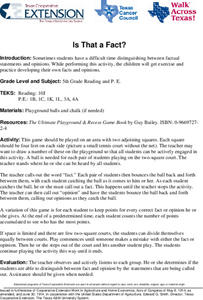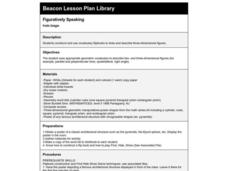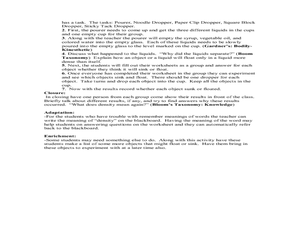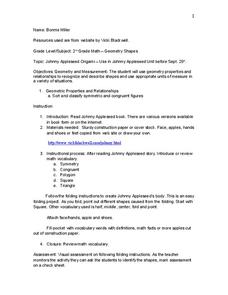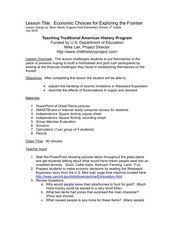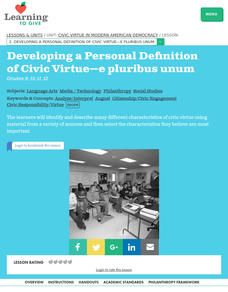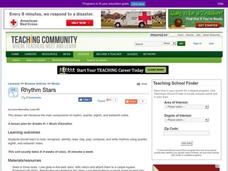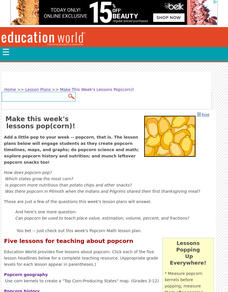Curated OER
Who Has...?
In this Algebra I worksheet, 9th graders represent verbal expression algebraically and evaluate the expressions for the given replacement values of the variables. The three page worksheet contains the instructions for the card game and...
Curated OER
Is That a Fact?
Fifth graders use physical activity to help them distinguish between facts and opinions. They are broken up into pairs and students give a fact or opinion (based on the call by the teacher) when the ball is bounced to them.
Curated OER
Figuratively Speaking
Third graders construct and use vocabulary flipbooks to draw and describe three-dimensional figures. They utilize worksheets and access websites imbedded in this plan which help them construct their books.
Curated OER
Liquids: Floating and Sinking
Third graders conduct an experiment. In this floating and sinking liquids lesson, 3rd graders discuss density and investigate it using syrup, vegetable oil and colored water. Students observe the results and complete a worksheet.
Curated OER
Johnny Appleseed Origami
Second graders make an origami Johnny Appleseed. For this geometry lesson students follow folding instructions. They find different geometric shapes while they are folding. They create Johnny Appleseed's body and attach a face and hands...
Curated OER
STEP INTO IT WITH GOLDILOCKS
First graders use sequencing to recall and tell the story of Goldilocks and the Three Bears. They create a storyboard using pencils first and then crayons with six illustrations in sequence.
Curated OER
Economic Choices for Exploring the Fronteir
Fourth graders explain the hardship of economic limitations in Westward Expansion . They describe the effects of fluctuations in supply and demand. They put themselves in the place of pioneers hoping to build a homestead.
Curated OER
Hello My Name is . . . Helvetica
Students play various games to help create a classroom community. In this name recognition lesson, students combine their name recognition skills with newly learned art and geometric vocabulary. First students discover vocabulary that...
Curated OER
Environmental Problems
Students explore the environment by completing environmental problem worksheets. In this pollution instructional activity, students identify the biggest threats to our environment such as deforestation, global warming, and pollution....
Curated OER
Numbers Beyond Reason!
Fourth graders use the story of the discovery of irrational numbers to explore the different classes of numbers, the different ways in which numbers may be represented, and how to classify different numbers into their particular class.
Curated OER
Civic Virtue in Democracy
Students identify and describe characteristics of civic virtue. Following a class discussion, they create their own definitions of civic virtue. They write essays based on their own definitions and formulate conclusions on the state of...
Curated OER
Rhythm Stars
Learners listen, clap, compose and identify various rhythms. In this rhythm lesson, students practice rhythm with rhythm cards. Learners become familiar with stick notation. Students glue Popsicle sticks to illustrate rhythms.
Curated OER
Make This Week's Lessons Pop(corn)!
Students create popcorn timelines, maps, and graphs; do popcorn science and math; explore popcorn history and nutrition; and munch leftover popcorn snacks too!,
Curated OER
Count The Letters
Students perform activities involving ratios, proportions and percents. Given a newspaper article, groups of students count the number of letters in a given area. They use calculators and data collected to construct a pie chart and bar...
Curated OER
Water Treatment Plant
Second graders create their own water treatment system. In this water treatment lesson, 2nd graders create the water treatment system and record how it works. Students list materials they used and write about what they saw. Students then...
Curated OER
Push or Pull
Young scholars discover that one way to change how something is moving is to give it a push or a pull. They design their own boats and work with 'The Great Boat Push' worksheet to compare how their boats move when they are pushed or...
Curated OER
Adding Tenths
Third graders pictorially represent tenths place with decimal bars and add decimals in the tenths place; students use decimal bars to represent tenths and solve simple addition problems with the tenths place.
Curated OER
What Does Average Look Like?
Fifth graders explore the concepts of range, median, mode, and mean through the use of graphs drawn from models. They use manipulatives to represent data they have collected within their groups, and compare the differences between mode,...
Curated OER
Grocery Store
Students explore food and grocery stores. In this lesson on foods, students are introduced to the food pyramid and healthy eating through a variety of center activities. Students have to opportunity to role-play working at a grocery store.
Curated OER
Reflections of Symmetry
Students use video and the Internet to identify examples of bilateral and radial symmetry in the world around them. They create symmetrical reflection designs using pattern blocks and paper.
Curated OER
Filling in the Picture
Young scholars study archaeological sites. They discover some of the problems inherent in choosing sites and what parts are chosen for excavation. They evaluate and explain their choices for study and articulate the process of...
Curated OER
Fractions and Panes
Students recognize the fractional values of window panes as part of the whole window. In this window panes lesson plan, students listen to a story about window panes and sing a song. Students look at pictures of windows and write...
Curated OER
The Shape of Things
In this family activity activity, students work with family members to discover the various shapes of objects around them. Students complete the presented activity and respond to 2 short answer questions about what they have discovered...



